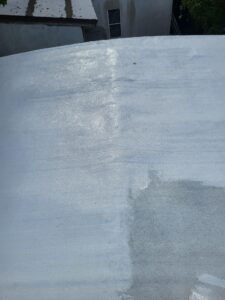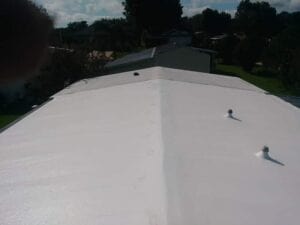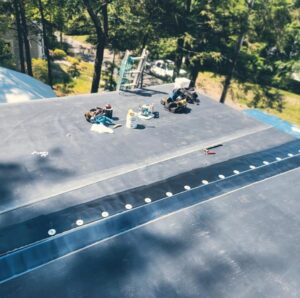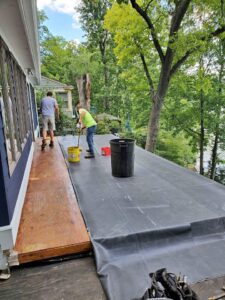Are you looking for a durable and reliable roofing material for your mobile home? Look no further than rubber roofing! In this article Mobile Home Rubber Roofing: Options & Coatings we will cover everything rubber roofs.
Mobile Home Rubber Roofing: Options & Coatings
Rubber roofs have become increasingly popular in recent years due to their ability to withstand harsh weather conditions and offer long-lasting protection.
There are different types available for mobile homes. Some of the most common types include EPDM, TPO, and PVC. Each type has its own unique features and benefits that make it ideal for certain situations.
Proper installation of vents is crucial when using rubber roofing on a mobile home. This ensures proper ventilation and prevents moisture buildup that could lead to damage or mold growth.
From installation to repair, we’ve got you covered. So whether you’re looking to install a new roof or repair an existing one, read on to learn more about how rubber roofing can benefit your home.
Some questions we’ll answer throughout this article include: What is a mobile home rubber roof? How do I install mobile home rubber roofing? How do I repair my mobile home rubber roofing?
So let’s dive in and explore the world of rubber roofing for mobile homes!

Mobile Home Rubber Roofing: Benefits
Highly Durable Material
One of the benefits of using rubber roofing on a mobile home is its durability. Rubber roofing can last up to 50 years, making it a long-term investment for mobile homeowners. Unlike traditional asphalt shingles that have a lifespan of only 20-30 years, rubber roofs are made from synthetic materials that can withstand harsh weather conditions and high foot traffic. This means that you won’t have to worry about replacing your roof every few years, saving you time and money in the long run.
Resistant to Extreme Weather Conditions
Mobile homes are often located in areas prone to extreme weather conditions such as heavy rain, hail, and strong winds. Rubber roofing is highly resistant to these weather elements which makes it an ideal choice for mobile homeowners. The material is designed to expand and contract with temperature changes which helps prevent leaks and cracks in the roof. Rubber roofing has excellent insulation properties which can help reduce energy costs by keeping your home cooler in the summer and warmer in the winter.
Lightweight and Easy to Install
Another advantage of rubber roofing is its lightweight nature which makes it easy to install. This reduces labor costs and installation time compared to other types of roofing materials like metal or tile roofs. Rubber roofing comes in large sheets that can be easily cut to fit any size or shape roof without requiring special tools or equipment.
Eco-Friendly Material: Mobile Home Rubber Roofing
Rubber roofing is also an eco-friendly material that can contribute to a sustainable living environment. The material is made from recycled materials such as old tires which helps reduce waste in landfills. When it’s time to replace your mobile home rubber roofing, the old material can be recycled again instead of being thrown away like traditional asphalt shingles.
For the best mobile home rubber roofing materials available and shipped right to your doorstep visit this link. Great deals running right now.

Cost-Effective Option
When considering the cost of putting a rubber roof on a mobile home, it’s important to note that while it may be more expensive than traditional asphalt shingles, it’s a worthwhile investment in the long run. The durability of rubber roofing means you won’t have to replace your roof as often, saving you money on maintenance and repair costs over time. The energy-saving properties of rubber roofing can help reduce your monthly utility bills which can offset the initial cost of installation.
Different Options Mobile Home Rubber Roofing
Rubber roofing is an ideal option for mobile homes due to its durability, flexibility, and resistance to harsh weather conditions. There are different options available for rubber roofing on mobile homes, including EPDM, TPO, and PVC. Choosing the right option depends on factors such as budget and climate.
EPDM Rubber Roofing
EPDM (Ethylene Propylene Diene Monomer) rubber roofing is the most popular choice for mobile homes due to its affordability and long-lasting performance. It is made from a synthetic rubber material that can withstand extreme temperatures and weather conditions.
One of the advantages of EPDM rubber roofing is its ease of installation. It comes in large sheets that can be cut to fit any size or shape of the roof. The sheets are then glued down using adhesive or fastened with screws and plates.
Another advantage of EPDM rubber roofing is its low maintenance requirements. It does not require regular cleaning or coating like other types of roofs. However, it is essential to inspect it periodically for any damages or leaks.
TPO Rubber Roofing
TPO (Thermoplastic Olefin) rubber roofing is another option available for mobile homes. It is made from a blend of plastic and rubber materials that make it durable and resistant to UV rays.
One advantage of TPO rubber roofing is its energy efficiency. It reflects sunlight instead of absorbing it, which helps to reduce cooling costs during hot weather.
TPO rubber roofing also has low maintenance requirements similar to EPDM rubber roofing. However, it may need occasional cleaning with mild soap and water to remove dirt buildup.
Read our article on Power Your Mobile Home: Best Generator Options.
PVC Rubber Roofing: Mobile Home Rubber Roofing
PVC (Polyvinyl Chloride)mobile home rubber roofing is a more expensive option compared to EPDM and TPO but offers superior performance in harsh climates. It is made from a thermoplastic material that resists damage from chemicals, fire, punctures, and UV rays.
PVC mobile home rubber roofing is also energy efficient due to its reflective properties. It can reflect up to 90% of sunlight, reducing cooling costs during hot weather.
For the best mobile home rubber roofing materials available and shipped right to your doorstep visit this link. Great deals running right now.

One advantage of PVC rubber roofing is its ease of maintenance. It requires minimal cleaning and coating to maintain its performance and appearance.
How to Repair a Rubber Roof on a Mobile Home
To repair a rubber roof on a mobile home, follow these steps:
Clean the damaged area with soap and water to remove any dirt or debris.
Dry the area thoroughly using a clean cloth or towel.
Cut a piece of rubber patch material slightly larger than the damaged area.
Apply adhesive to the underside of the patch material and place it over the damaged area.
Press down firmly on the patch material to ensure it adheres properly.
Allow the adhesive to dry completely before inspecting for any leaks or damages.
Seamed and Seamless Mobile Homes Rubber Roofing
Rubber roofing has become a popular choice for mobile homes due to its durability, flexibility, and resistance to harsh weather conditions. There are two types: seamed and seamless.
Seamed Rubber Roofing
Seamed rubber roofing is made up of individual sheets that are glued together at the seams. While this type of roofing is cheaper than seamless rubber roofing, it requires regular maintenance due to the potential for seam separation and leaks.
To prevent leaks in seamed rubber roofing, homeowners must regularly inspect their roofs and seal any gaps or cracks that may have formed in the seams. This can be time-consuming and costly over time, as repairs may need to be done frequently.
Seamless Rubber Roofing
Seamless rubber roofing is a popular choice for manufactured homeowners as it eliminates the need for seams altogether. This not only reduces the risk of leaks but also makes installation faster and easier.
There are three main forms of seamless rubber roofing: EPDM, PVC, and TPO membrane. Each offers unique benefits:
EPDM (ethylene propylene diene monomer) is a synthetic rubber material that is highly durable and resistant to UV radiation.
PVC (polyvinyl chloride) membrane is lightweight, flexible, and easy to install.
TPO (thermoplastic olefin) membrane is energy-efficient and environmentally friendly.
While asphalt shingles or metal may be cheaper options initially, they do not offer the same quality or durability as these forms of rubber roofing.
When installing seamless mobile home rubber roofing, it’s important to hire a professional with experience in this type of installation. They will ensure proper installation techniques are used so that your roof remains leak-free for years to come.

In addition to being more durable than other materials like asphalt shingles or metal roofs, seamless rubber also provides better insulation, which can save homeowners money on their energy bills.
Choosing the Best Rubber Roofing Material for Your Mobile Home
If you own a mobile home, one of the most important decisions you will make is choosing the right roofing material. A rubber roof is a popular choice due to its durability and affordability.
Rubber Roofing Materials for Mobile Homes
Rubber roofing materials are an excellent choice for mobile homes because they are lightweight, durable, and long-lasting. The most common type of rubber roofing material used in mobile homes is a rubber membrane. This type of material is made from synthetic rubber and comes in large sheets that can be cut to fit any size roof.
Another option for mobile home roofing is metal roofing materials such as aluminum. While metal roofs can be more expensive than rubber roofs, they offer several advantages such as being fire-resistant and energy-efficient.
When choosing a roofing material for your mobile home, it’s essential to consider factors such as climate, budget, and maintenance requirements. Here are some things to keep in mind when selecting a rubber roofing material:
Climate: If you live in an area with extreme weather conditions, such as high winds or heavy snowfall, you may want to consider a thicker rubber membrane.
Budget: Rubber roofs are generally less expensive than other types of roofing materials; however, the cost can vary depending on the quality of the product.
Maintenance: Rubber roofs require minimal maintenance and can last up to 50 years with proper care.
You might also be interested in our article:
Ready to Assemble Bathroom Cabinets.
Pros and Cons of Mobile Home Rubber Roofing Materials
Like any other product on the market today, there are pros and cons associated with using rubber roofing materials for your mobile home. Here are some things to keep in mind:
Pros
Durability: Rubber roofs have been known to last up to 50 years with proper care.
Affordability: Compared to other types of roofing materials, rubber roofs are relatively inexpensive.
Lightweight: Rubber roofs are lightweight and easy to install.
Energy-efficient: Rubber roofs can help reduce energy costs by reflecting sunlight and keeping your home cooler in the summer.
Cons
Limited color options: Rubber roofing materials come in limited colors, which may not match the aesthetic of your mobile home.
Difficult to repair: If a rubber roof is damaged, it can be challenging to repair without replacing the entire roof.
May require professional installation: While some homeowners may be able to install a rubber roof themselves, others may need to hire a professional.
How Much Does a Mobile Home Rubber Roofing Cost?
The cost of a mobile home rubber roofing can vary depending on several factors such as the size of your roof and the quality of the product. On average, you can expect to pay between $3000-$5000 for a new rubber roof installed on your mobile home. Keep in mind that this price does not include any additional repairs or maintenance that may be required.
Proper Maintenance and Repair for a Mobile Home Roof
Mobile homes are an affordable housing option that has been gaining popularity in recent years. One of the most important parts of a mobile home is its roof, which protects the interior from harsh weather conditions. If you own a mobile home with a rubber roof, it’s essential to keep it well-maintained to ensure its longevity.
Regular Maintenance is Crucial
Regular maintenance is crucial for extending the lifespan of any type of roofing material. For mobile homeowners with rubber roofs, regular inspections should be conducted at least twice per year. Inspections should include checking for any signs of damage or wear and tear such as cracks, tears, or punctures.
In addition to inspections, regular cleaning is also necessary to maintain the integrity of the rubber roof. Dirt and debris can accumulate on the surface over time, leading to discoloration and degradation if not cleaned regularly. A soft-bristled brush or pressure washer can be used to remove dirt and debris without damaging the surface.
Repair Options Before Replacement
If you notice any damage during your inspections or cleaning routine, don’t panic! Rubber roofs can be repaired rather than replaced entirely, which saves both time and money. Small cracks or punctures can be patched up using specialized sealants made explicitly for rubber roofs.
For more extensive repairs such as leaks caused by damaged flashing or vents, professional help may be required. Hiring an experienced contractor will ensure that repairs are done correctly without causing further damage to your current roof.
Different Roofing Systems Require Specific Techniques
Different roofing systems require specific maintenance and repair techniques. Shingle roofs are relatively easy to maintain but may require occasional replacement if damaged significantly. Metal roofs are durable but may require additional coatings over time to prevent rusting or corrosion.
Flat roofs require special attention due to their unique design. They require regular inspections to ensure that water is not pooling on the surface, which can lead to leaks and other damage. If you have a flat rubber roof, make sure to keep it clean and free of debris to prevent any issues.
Consider Roof Overs
If your current roof is beyond repair or nearing the end of its lifespan, you may want to consider a new roof installation. One option for mobile homeowners is a “roof over,” which involves installing a new roof over the existing one without removing it entirely.
Roof overs are an affordable alternative to full roof replacements and can be done quickly with minimal disruption to your daily routine. They also provide additional insulation, which can help reduce energy costs in the long run.
Roof Coating
Another option for extending the life of your rubber roof is applying a coating specifically designed for rubber roofs. These coatings protect against UV rays and other environmental factors that can cause damage over time. A coating will also give your roof a fresh look while providing extra protection against leaks and other types of damage.
Experienced Professionals Providing Quality Rubber Roofing Solutions
It’s essential to work with experienced professionals who understand the unique challenges involved. Fortunately, many companies have been providing high-quality rubber roofing solutions for years.
These experts use top-of-the-line materials and equipment to ensure that your new roof will last for decades. They also provide comprehensive warranties on their workmanship so that you can rest assured knowing that your investment is protected.
Conclusion
Rubber roofing is a crucial aspect of maintaining your mobile home’s structural integrity and longevity. By using rubber roofing, you can ensure that your mobile home is protected from harsh weather conditions, leaks, and other potential damages. The different options available for rubber roofing allow you to choose the best material that meets your needs and budget.
Seamed and seamless rubber roofing offer various benefits that cater to different preferences. Proper maintenance and repair of your mobile home roof are essential in ensuring its longevity. Our team of experts offers reliable services to help maintain and repair your rubber roof.
Living in Florida counties or cities requires a durable and sturdy roof that can withstand extreme weather conditions. We offer quality rubber roofing services to residents in Florida counties and cities.
Investing in high-quality rubber roofing for your mobile home is a wise decision that guarantees long-term protection against damages caused by harsh weather conditions. Don’t wait until it’s too late; contact us today for all your rubber roofing needs.
For the best mobile home rubber roofing materials available and shipped right to your doorstep visit this link. Great deals running right now.
Mobile Home Rubber Roofing: FAQs
Q1: Is Rubber Roofing Expensive?
A1: The cost of rubber roofing varies depending on the type of material used, size of the roof, location, among other factors. However, investing in high-quality materials pays off in the long run as it ensures durability and reduces repair costs.
Q2: How Long Does Rubber Roofing Last?
A2: With proper installation and maintenance, most rubber roofs last between 25-30 years or more.
Q3: Can I Install Rubber Roofing Myself?
A3: While it’s possible to install some types of rubber roofs yourself, we recommend hiring professionals to ensure proper installation.
Q4: What Happens If My Rubber Roof Gets Damaged?
A4: It’s recommended to contact professionals immediately if you notice any damage on your rubber roof. Ignoring small damages can lead to more significant problems and costly repairs in the future.
Q5: Can I Walk on My Rubber Roof?
A5: It’s not advisable to walk on your rubber roof as it can cause damage. If you need to access your roof, we recommend contacting professionals who use specialized equipment to minimize damage.
You might also be interested in our articles:

